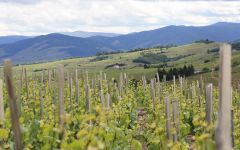Stephane Aviron Morgon Cote du Py Vieilles Vignes 2017
-
Robert
Parker -
Wine
Spectator



Product Details
Your Rating
Somm Note
Winemaker Notes
Stephane Aviron’s Morgon Cote du Py is Burgundy in every way, witha striking resemblance to a 1er Cru Pinot Noir from the Cote de Nuits. This wine is sim-ply exceptional! The nose is elegant and layered with notes of earth and berry. The wine is rich and very structured with a healthy dose of crushed berry fruit leading to a firm, well structured finish.
Professional Ratings
-
Robert Parker's Wine Advocate
Aviron's 2017 Morgon Côte du Py Vieilles Vignes is showing very well, unfurling in the glass with a lovely bouquet of cherries, raspberries, smoked meats, dark chocolate and peonies. On the palate, the wine is medium to full-bodied, velvety and layered, with a fleshy core of fruit, fine and powdery tannins and succulent acids, concluding with a nicely defined finish. This is sourced from Jean-Marc Burgaud, and it shares more than a few characteristics with his own Côte du Py bottling in this vintage.
-
Wine Spectator
This light-bodied red shows charm, with an aromatic profile displaying raspberry, peach and spice notes, lined with rose water and mineral flavors. Lingering finish. Drink now through 2024.
Other Vintages
2021-
Wine
Enthusiast
-
Robert
Parker
-
Wine
Spectator
-
Wine
Spectator




Stephane Aviron has adopted an almost radical return to tradition in Beaujolais: sustainable viticulture, extremely old vines and classic Burgundian techniques. His cru Beaujolais drink like fine Burgundy.
Historically considered "poor man’s Burgundy," a modern movement toward fruity, simple, quaffing wines boosted sales but eroded the region’s traditional quality. Stephane Aviron has reversed the trend. By focusing on the Beaujolais village crus, the best sites for unique, expressive wines, and finding old parcels of vines, Aviron creates very expressive, age-worthy wines relying on traditional and new methods, including organic and biodynamic vineyard management. All wines are labeled "Vieilles Vignes," old vines, because the vines are at least 40 years old. Stephane Aviron’s wines are authentic in every way.

Delightfully playful, but also capable of impressive gravitas, Gamay is responsible for juicy, berry-packed wines. From Beaujolais, Gamay generally has three classes: Beaujolais Nouveau, a decidedly young, fruit-driven wine, Beaujolais Villages and Cru Beaujolais. The Villages and Crus are highly ranked grape growing communes whose wines are capable of improving with age whereas Nouveau, released two months after harvest, is intended for immediate consumption. Somm Secret—The ten different Crus have their own distinct personalities—Fleurie is delicate and floral, Côte de Brouilly is concentrated and elegant and Morgon is structured and age-worthy.

The bucolic region often identified as the southern part of Burgundy, Beaujolais actually doesn’t have a whole lot in common with the rest of the region in terms of climate, soil types and grape varieties. Beaujolais achieves its own identity with variations on style of one grape, Gamay.
Gamay was actually grown throughout all of Burgundy until 1395 when the Duke of Burgundy banished it south, making room for Pinot Noir to inhabit all of the “superior” hillsides of Burgundy proper. This was good news for Gamay as it produces a much better wine in the granitic soils of Beaujolais, compared with the limestone escarpments of the Côte d’Or.
Four styles of Beaujolais wines exist. The simplest, and one that has regrettably given the region a subpar reputation, is Beaujolais Nouveau. This is the Beaujolais wine that is made using carbonic maceration (a quick fermentation that results in sweet aromas) and is released on the third Thursday of November in the same year as harvest. It's meant to drink young and is flirty, fruity and fun. The rest of Beaujolais is where the serious wines are found. Aside from the wines simply labelled, Beaujolais, there are the Beaujolais-Villages wines, which must come from the hilly northern part of the region, and offer reasonable values with some gems among them. The superior sections are the cru vineyards coming from ten distinct communes: St-Amour, Juliénas, Chénas, Moulin-à-Vent, Fleurie, Chiroubles, Morgon, Regnié, Brouilly, and Côte de Brouilly. Any cru Beajolais will have its commune name prominent on the label.
